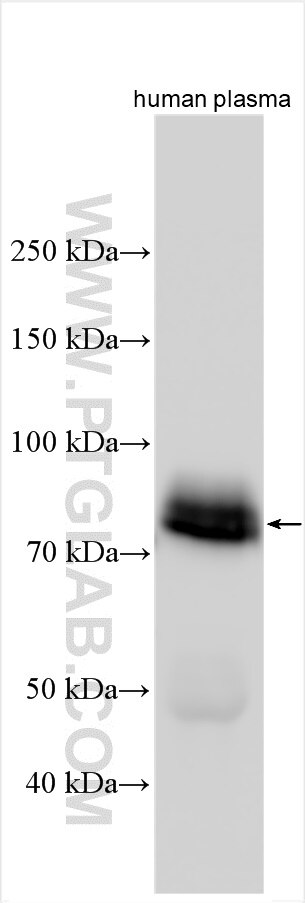Anticorps Polyclonal de lapin anti-PLTP
PLTP Polyclonal Antibody for WB, ELISA
Hôte / Isotype
Lapin / IgG
Réactivité testée
Humain
Applications
WB, ELISA
Conjugaison
Non conjugué
N° de cat : 51123-1-AP
Synonymes
Galerie de données de validation
Applications testées
| Résultats positifs en WB | plasma humain, |
Dilution recommandée
| Application | Dilution |
|---|---|
| Western Blot (WB) | WB : 1:1000-1:6000 |
| It is recommended that this reagent should be titrated in each testing system to obtain optimal results. | |
| Sample-dependent, check data in validation data gallery | |
Informations sur le produit
51123-1-AP cible PLTP dans les applications de WB, ELISA et montre une réactivité avec des échantillons Humain
| Réactivité | Humain |
| Hôte / Isotype | Lapin / IgG |
| Clonalité | Polyclonal |
| Type | Anticorps |
| Immunogène | PLTP Protéine recombinante Ag0681 |
| Nom complet | phospholipid transfer protein |
| Masse moléculaire calculée | 54.7 kDa, 81 kDa |
| Poids moléculaire observé | 80 kDa |
| Numéro d’acquisition GenBank | BC019898 |
| Symbole du gène | PLTP |
| Identification du gène (NCBI) | 5360 |
| Conjugaison | Non conjugué |
| Forme | Liquide |
| Méthode de purification | Purification par affinité contre l'antigène |
| Tampon de stockage | PBS with 0.02% sodium azide and 50% glycerol |
| Conditions de stockage | Stocker à -20°C. Stable pendant un an après l'expédition. L'aliquotage n'est pas nécessaire pour le stockage à -20oC Les 20ul contiennent 0,1% de BSA. |
Informations générales
PLTP (phospholipid transfer protein) belongs to the family of lipid-binding and lipid-transfer proteins. PLTP is involved in the distribution and metabolism of high density lipoprotein ( HDL ) and reverse cholesterol transfer ( RCT ). In plasma, PLTP catalyzes the transfer of phospholipids ( mainly phosphatidylcholine ) between lipoproteins (PMID: 29558025).
Protocole
| Product Specific Protocols | |
|---|---|
| WB protocol for PLTP antibody 51123-1-AP | Download protocol |
| Standard Protocols | |
|---|---|
| Click here to view our Standard Protocols |


